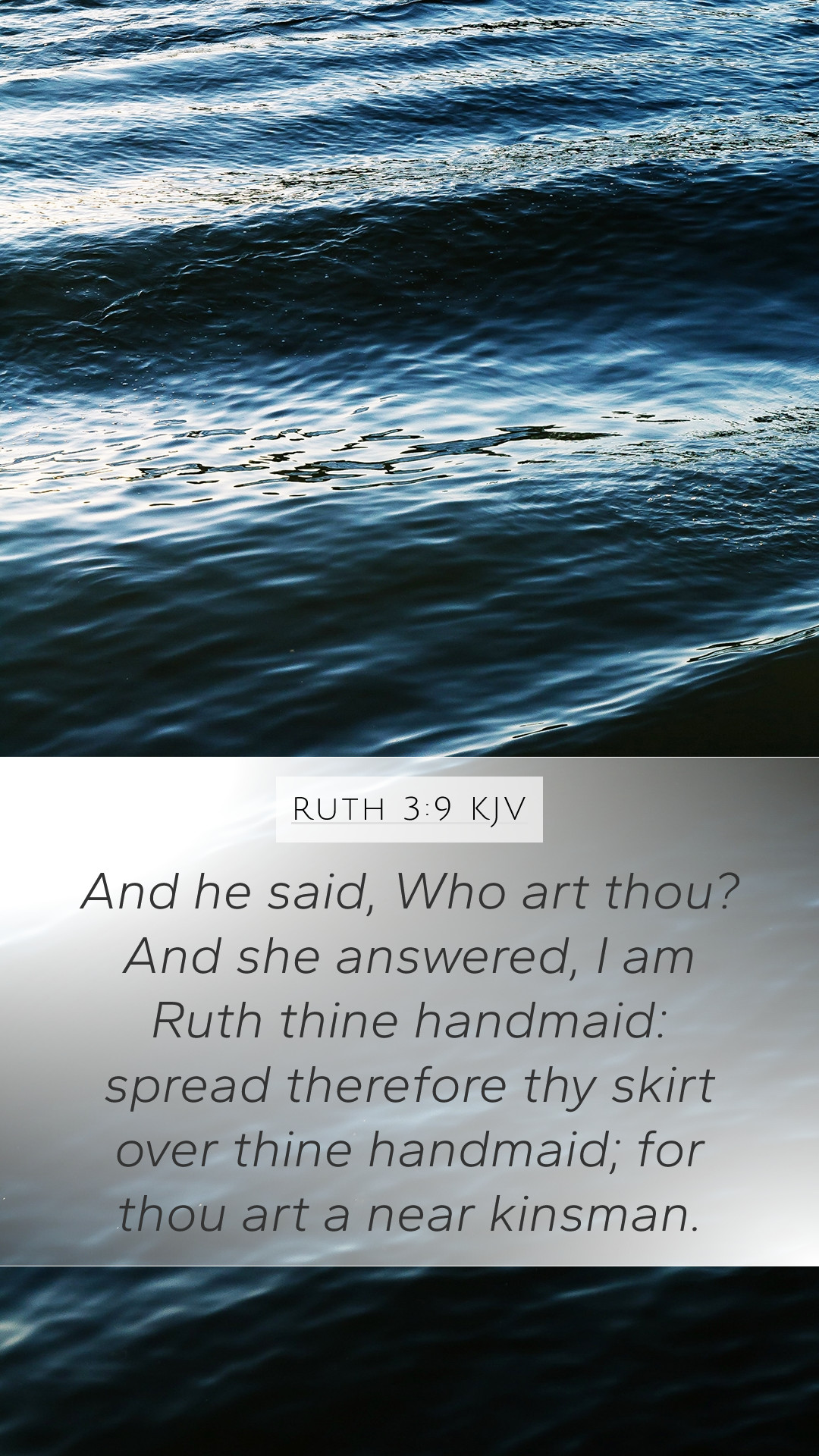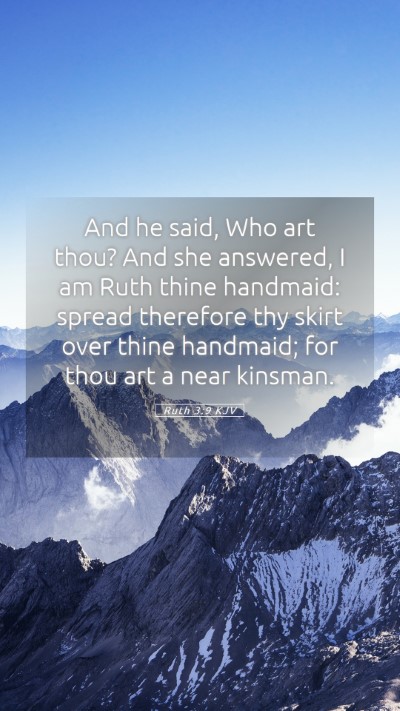Old Testament
Genesis Exodus Leviticus Numbers Deuteronomy Joshua Judges Ruth 1 Samuel 2 Samuel 1 Kings 2 Kings 1 Chronicles 2 Chronicles Ezra Nehemiah Esther Job Psalms Proverbs Ecclesiastes Song of Solomon Isaiah Jeremiah Lamentations Ezekiel Daniel Hosea Joel Amos Obadiah Jonah Micah Nahum Habakkuk Zephaniah Haggai Zechariah MalachiRuth 3:9 Meaning
What is the meaning of Ruth 3:9?
And he said, Who art thou? And she answered, I am Ruth thine handmaid: spread therefore thy skirt over thine handmaid; for thou art a near kinsman.
Ruth 3:9 Bible Verse Meaning
Understanding Ruth 3:9
Ruth 3:9 states, "And he said, Who art thou? And she answered, I am Ruth thy handmaid: spread therefore thy skirt over thine handmaid; for thou art a near kinsman."
This verse captures a pivotal moment in the story of Ruth, highlighting themes of redemption, loyalty, and divine providence. The interaction between Ruth and Boaz is filled with cultural significance and theological implications.
Verse Breakdown
- Setting: The context is during the time of the judges in Israel, a period marked by social upheaval.
- Characters: Ruth, a Moabite widow, seeks security from Boaz, a relative of her deceased husband.
- Cultural Context: The act of spreading one's skirt signifies protection and a request for marriage.
Bible Verse Meaning
According to public domain commentaries, the verse embodies Ruth's appeal to Boaz as her redeemer. Various commentators provide insights into the implications of her actions:
Matthew Henry's Commentary
Matthew Henry emphasizes Ruth's humility and boldness in approaching Boaz. He notes the significance of the term "near kinsman," indicating Boaz's legal and moral obligation to care for Ruth and Naomi. Henry appreciates Ruth's faith and understanding of the customs regarding levirate marriage that governed Israelite society.
Albert Barnes' Commentary
Albert Barnes draws attention to the deeper meaning of Ruth's request. He elucidates that it is not merely a request for physical protection but a plea for marital union and a restoration of family lineage. Barnes indicates that Ruth's actions also demonstrate a profound trust in God’s providence and His plan for redemption through Boaz.
Adam Clarke's Commentary
Adam Clarke focuses on the role of kinsmanship and the law of redemption. He draws connections between Ruth's request for Boaz to "spread his skirt" over her, linking it to the broader theme of God’s grace and the unfolding plan of redemption in Scripture. Clarke comments on the significance of this act in relation to divine favor and the importance of kinsmen relationships in maintaining family heritage.
Theological Implications
Theological reflections on Ruth 3:9 delve into broader biblical themes:
- Redemption: Ruth’s action symbolizes a desire for redemption—not just for herself but also for her deceased husband’s family.
- God’s Providence: This verse encapsulates the idea that God orchestrates events in our lives, using ordinary means to fulfill His divine plan.
- Faith and Loyalty: Ruth’s commitment to Naomi and her willingness to step out in faith highlight the importance of loyalty and trust in God’s guidance.
Practical Applications
Understanding Ruth 3:9 leads to several practical applications for daily life:
- Trusting God’s Plan: Like Ruth, we are encouraged to trust in God's providence, even in uncertain circumstances.
- Seeking Redemption: This verse reminds us to seek redemption through Christ, as He is our ultimate Kinsman Redeemer.
- Courage in Vulnerability: Ruth’s willingness to be vulnerable and take bold steps inspires believers to engage in faith-filled actions.
Cross References
Several other scriptures enhance the understanding of Ruth 3:9:
- Leviticus 25:25: Discusses the laws of redemption regarding a kinsman’s responsibilities.
- Deuteronomy 25:5-10: Explains levirate marriage and the duty of a brother to support his deceased brother’s family.
- Matthew 1:5: Highlights Ruth in the genealogy of Jesus, connecting her story to the narrative of redemption.
Conclusion
Ruth 3:9 serves as a profound illustration of faith, redemption, and the fulfillment of God’s promises. Through her actions, she models trust in divine providence, encouraging modern readers to deepen their understanding of Scripture and its application in our lives. The themes uncovered through this verse echo throughout the Bible, appealing to those undertaking Bible study insights and explorations.
As you engage in Bible study groups or utilize Bible study tools, consider the significance of this verse and how it relates to the overarching narrative of Scripture, enhancing your Bible study lessons and personal growth.


